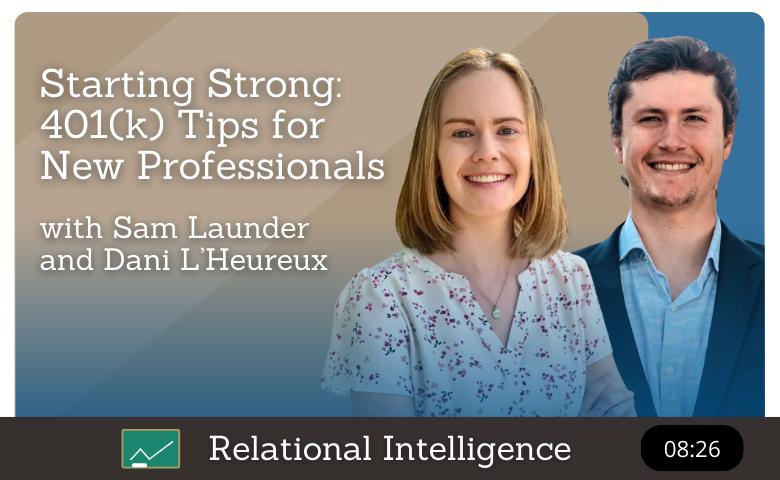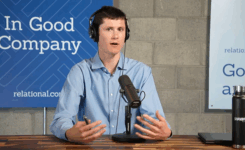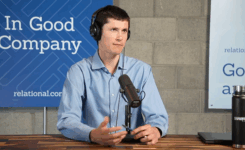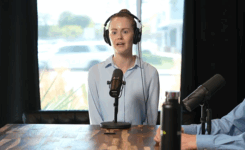And so you guys came into the workforce, what, four or five years ago for you, Sam? And Dani, five, six years ago? That neighborhood?
Dani L’Heureux
Something like that.
Mike Rankin
So you guys are, yeah, yeah, yeah. Mid to late 20s, right?
And so for many of us joining the workforce the first time, you know, signing up in the 401k plan could be a little bit of a daunting experience. And maybe Sam, we’ll start with you real quick because you are a 401k advisor, but also just as an individual, like, you know, how do you, how did you think about it when you first got started and any tips or advice you might give to somebody coming into the workforce?
Sam Launder
Sure. Yeah, I think it’s kind of a three-pronged approach when I look at it. It’s like, how much are you going to contribute, what you’re going to invest in, and then is your money going to be pre-tax or Roth?
So if I’m thinking about how much to contribute, I mean, you can get any recommendation from any sort of financial advisor and you’ll hover around a 10% savings target. That’s 10% of your salary. So I started with 10% because I’d heard other financial advisors, you know, recommend that as a benchmark deferral rate.
And then that kind of moves to where you want to invest that money. And there’s a few different options, obviously. There’s asset allocation funds.
So there’s, there’s, you know, growth funds that are positioned toward a specific risk tolerance, like growth or aggressive. But then there’s also target date funds. So, you know, if you’re in your 20s and you think you’re probably going to retire in or around the year 2065 and you have that, you know, long runway, then a target date fund is great because you can kind of set it and let the glide path of the target date do its thing over time.
So certainly asset allocation funds come to mind. And because when you’re in your 20s, you have such a long runway, meaning you’re not going to need that money for 40, 50, maybe even 60 years, depending on how long you work and how long you live. Even just the S&P 500, just going into an index, your low cost investment option, and it’s just going to track the U.S. stock market, which if we look back 50 years and you could buy, you know, shares of the S&P 500 from 50 years ago and you get the prices that they are now, that’s certainly a prudent investing strategy looking backwards. And then the final thing I would touch on is that third pillar where it’s either pre-tax contributions or Roth after-tax contributions. And for me as a younger, you know, employee in my 20s, it’s certainly a time where you can explore the Roth option. You may be in a lower tax bracket in your 20s than you will be, you know, later on in your life.
And there’s also uncertainty about the future of tax rates in general. So I think if you’re able to pay the tax upfront and go into a Roth after-tax account, then you’re able to let your money grow tax-free and be withdrawn tax-free. I think that’s a big benefit for younger investors.
Mike Rankin
Awesome. And so, Dani, turning to you, and obviously as, you know, not an advisor, you’re a director of operations, but also somebody that, you know, came into the workforce and had to try to, you know, figure it out. I mean, what either, you know, what would maybe be a little advice you might have for somebody coming into the workforce?
And then how did you go about finding out, hey, like, what should I do here, right? Because sometimes it just feels like so opaque, like where do I get the information even?
Dani L’Heureux
Yeah, I think the most important thing that I would say is to just get started. I mean, Sam gave a lot of good advice about, you know, the S&P 500 and the target retirement funds, target date retirement funds. I think that’s just a great place to start, because I definitely got pretty overwhelmed at first, you know, especially with your first 401k, and you get the email three, six, nine months, whatever, after you join this company, and it’s like, you can invest, and here’s this website, and there’s 80,000 funds that you can pick from.
It’s kind of freaky, but I would say it’s a little overwhelming at first, but it can’t hurt to just throw some money in there and start. I think Sam’s advice about 10% is a really good one. And then I also leaned on people I know, like a lot of my friends as well, that like I have a really good friend that’s also a financial advisor.
And I was kind of like, hey, I have no idea what I’m talking about, what I’m deciding between what I’m choosing here. Can you please help me out? And just kind of having that humility and vulnerability, and I don’t know what I’m doing here, but I’d rather make a good decision now, just because, I mean, time value of money is so important.
And I remember being told that just first and foremost, so much as a kid, just start as early as you can. It does not matter how much you put in. If you can’t put in a lot, just start early, because that 20 bucks is going to be much more, you know, 50 years down the road.
Mike Rankin
Yes, yeah, without question. And such good advice, because, you know, a couple things, as you were talking, come to mind. When I started in the workforce, my parents told me, do 10%.
And I just did. I had no idea even what that meant. And then as I grew to learn more about the business, and you understand the math behind the time value of money, what I’m here to say at, you know, now the ripe old age of 55 is that I’m starting to see the benefits of the time value of money.
You know, what’s amazing to me is not much may happen in even the first 10 years. But in the second decade, in the third decade, it’s just remarkable how that money grows over time. So, Dani, I think that’s great advice.
What I’m hearing from you is, you know, just jump in, seek some advice, seek some mentorship, and then you kind of learn and grow. And then I think as you, you know, continue to do that over time, then, you know, maybe you didn’t make all the perfect decisions at the outset, but you build on that and you refine it over time.
Dani L’Heureux
Exactly. I love that quote — the best time to plant a tree is 10 years ago, and the second best time is today.
Something like that. So it’s like, if you feel like it’s too late as well, I think that’s another really big thing. You know, you see a lot of stuff, start when you’re seven.
I mean, seriously, it seems like it’s getting earlier and earlier nowadays. But if you’re, you know, if it says start at 21 and you’re 26, you still have so many years left and it’s so important to start as soon as you can.
Sam Launder
Yeah. Starting is certainly better than not starting, even if you think it’s too late. Exactly.
Yeah, for sure. And just that power of compound interest over time, like we touched on the time value of money, that’s kind of the fundamental point of finance. So understanding what that means and how that, you know, compound interest can work for you.
And Mike’s touching on it, you know, here in his 50s and he’s, you know, really seeing the effects of that compound interest in that third and fourth decade.
Mike Rankin
Yeah. You know, I haven’t looked at it within our 401k plan, but I would say within the 529 plan and the HSA that we’ve been investing in now for, you know, 20 years, in each of those accounts, about 40% of the money in those accounts is tax-free interest and growth and dividends on the principle that we put in. So you can really start to see it over that second decade is really when it comes to life.
So awesome. Well, Sam, Dani, thank you very much for sharing some of your time and your insight and wisdom with everyone today. And we really appreciate it.
Thank you very much.
Sam Launder
Thanks, Mike. Thanks, Dani.







